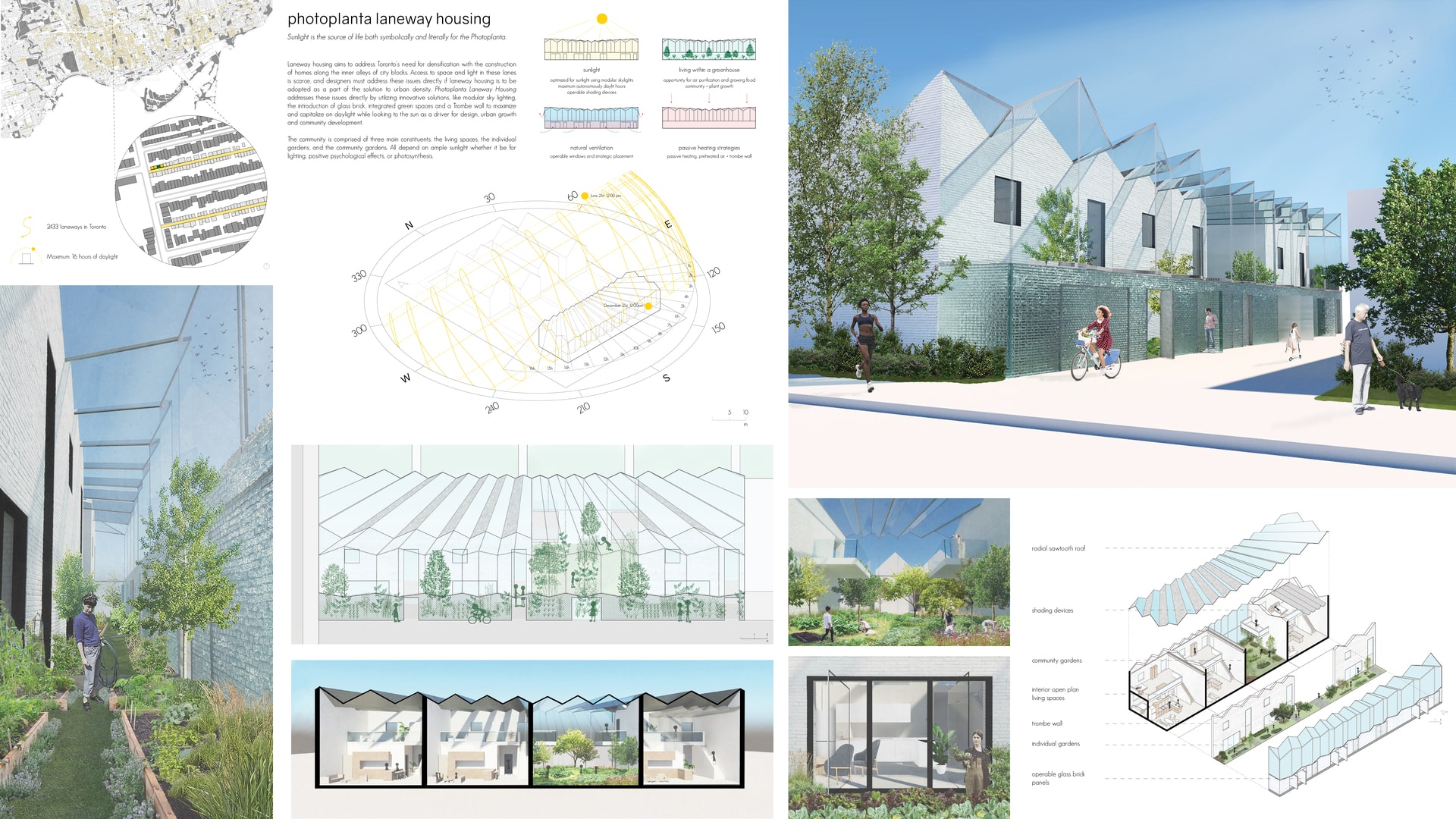Project Description
Laneway housing aims to address Toronto’s need for densification with the construction of homes along the inner alleys of city blocks. Access to space and light in these lanes is scarce, and designers must address these issues directly if laneway housing is to be adopted as a part of the solution for urban density. Photoplanta Laneway Housing addresses these issues directly by utilizing innovative solutions like modular sky lighting, the introduction of glass brick, integrated greenspaces and a Trombe wall for solar retention, to maximize and capitalize on daylight while looking to the sun as a driver for design, urban growth and community development. There is a stigma attached to laneway houses that expresses concerns around lack of light, space, nature and community. Understanding this, Photoplanta aims to shift the focus from a single laneway house to a larger ‘community considerate’ project in order to present a solution for density within a context that acknowledges that laneway houses will not exist in isolation. As such, this project should be understood as a more than laneway housing. It is designed to be a neighbourhood amenity that creates the opportunity for individuals to re-think how it is possible to live together in harmony with each other, nature, and light. The design encourages occupants to listen to their bodies natural rhythms and to use the expression of light and nature to enhance balance with the natural world in an extremely urban context. By inviting nature and life back into Toronto’s laneways, the project becomes a scalable, adaptable system of community focused dwellings that brings value to the lane and reinvigorates the character of the lane to one filled with life. Sunlight is the primary source of life for Photoplanta. The community is comprised of three main components: the living spaces, the individual gardens, and the community gardens. All of these spaces benefit from ample sunlight for illumination, positive psychological effects and more directly photosynthesis. From back to front, the townhome structure morphs into a greenhouse under one ‘sun fan’ saw-tooth roof structure. The roof design for this series of homes provides the best opportunity to capture daylighting throughout the entire year and creates an enclosed greenhouse system. Analysis of the sun path and solar angles on the site lead to the development of a site-specific solar fan. The geometry of the resultant solar fan influenced the roof structure to ensure the most solar access within the townhomes, the greenhouse, and the lane. Photoplanta’s radial sawtooth roof structure was designed based on the solar fan geometry to account for the maximum number of hours of daylighting in Toronto on the summer solstice, sixteen hours. This unique roof structure gives residents the opportunity to connect with the sun on an intimate level. Daylight and shadows from the roof geometry can be experienced within the entire space at different times of the day and year much like living in an active sun dial. The open layout of each unit allows the majority of the spaces to get constant access to daylight, and operable solar shades can be deployed as needed diffusing light throughout the dwelling. Sunlight is not only a necessity for better and healthier environments, but a requirement for plant life to grow and flourish especially in seasonal Canadian climates. In Photoplanta, the sun acts as a source of life not only for residents but for the vegetation grown within it. Each residence has access to its own green space as well as a community garden enclosed within the entire greenhouse structure. The greenhouse serves as an interstitial space between the lane and residences. It is a year-round extension of the living space into a light filled garden that blends the inside and outside. Glass brick lines the base of the greenhouse to provide privacy from the lane and has operable panels to integrate the living, green and public spaces. A thick brick Trombe wall is used for the front façade and acts as a threshold between greenhouse and house. The operable glass doors within the wall blur this threshold when required. The thick brick Trombe wall helps retain heat during the colder months and diffuse heat at night during warmer months, allowing for a more consistent temperature within greenhouse spaces. The public garden serves as a social space that enhances the sense of community within Photoplanta and facilitates a common goal of creating healthy, lively, community spaces. Environmental benefits of the greenhouse include its ability to capture solar heat gains to provide passive heating and preheated air to the residences in the winter. In addition, its operable panels provide natural ventilation. In an often-cooler Canadian climate, the integrated greenhouse also extends the short summer season. The ample amount of daylight let in through the roof enables many autonomously daylight hours annually.
